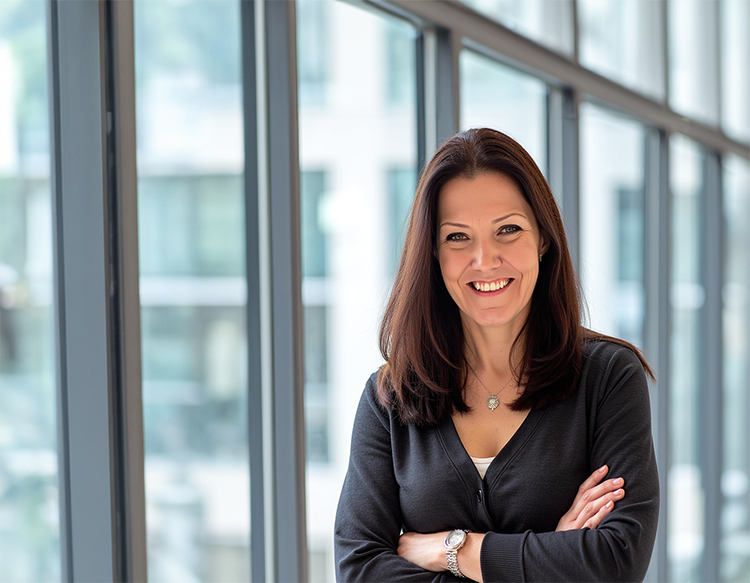
For 30 years, IMD’s Orchestrating Winning Performance (OWP) has been where global leaders go to challenge their thinking, sharpen their strategies, and stay ahead in an unpredictable world. Year after year, dozens of executives return – not just for fresh insights, but for an experience that reinvents itself with every iteration.
Flavia Sebastiani, Vice President of Global Planning and Customer Excellence at consumer healthcare group Kenvue, is one such leader. Having attended OWP multiple times, in 2019, 2022, and 2023, she finds that each visit brings new perspectives, challenges, and solutions.
‘OWP is not a course, it’s an evolving experience’
“What’s important for me is that OWP is an opportunity to engage with top faculty and pick different themes every time,” says Sebastiani. “Beyond that, it’s about meeting people outside my usual network – leaders from different industries, different countries, tackling different challenges.”
At OWP, held twice a year in both Lausanne and Singapore, the learning doesn’t come solely from lectures. The real magic happens in discussions with global peers, says Sebastiani. “You’re sitting with people from Australia to Senegal, running banks, running tech firms – it’s an incredibly diverse environment,” she explains. “The perspectives you gain are very different from a course focused solely on one topic.”
What sets IMD apart?
The IMD faculty is another key differentiator. “These guys are top-notch,” Sebastiani asserts. “They are not just academics; they have industry experience. They’ve seen these concepts play out in real life. It’s not about theory. It’s about making you think and reflect differently.”
For the Zug-based executive, this combination of world-class faculty and peer-to-peer learning makes OWP a special experience that’s hard to beat. “It’s about creating knowledge together. The conversations don’t end in the classroom; they extend into real-world business decisions,” she adds.
Why OWP never feels the same
Unlike traditional executive education programs, OWP isn’t static. “Every time I attend, it’s a different course, a different decision,” says Sebastiani. “IMD takes what’s happening in the world and brings it into the classroom. It’s incredibly current and relevant.”
She adds that this continuous evolution means leaders can return year after year and always walk away with fresh insights. “It all builds. You’re not learning one thing – you’re forming lasting relationships. Whenever I have a challenge, I can pick up the phone and say, ‘I have this perspective; what do you think?’”
From learning to action
Sebastiani’s experiences at OWP have directly influenced her leadership and strategy at Kenvue. “One of the most impactful discussions I had was about sustainability,” she recalls. “I was working on a green transformation in my company, and through OWP, I realized sustainability was about more than the final product.”
Through connections made at IMD, she was able to benchmark with a peer from a leading manufacturing company in Europe. “They faced sustainability challenges with plastic use, just like we were tackling issues in our supply chain,” Sebastiani says of Kenvue, which owns iconic consumer health brands such as Aveeno, Listerine, and Neutrogena. “Their strategies around value creation gave me tangible ideas that I could bring back and implement,” she adds.
One key insight that reshaped her approach to leadership was minimizing inventory to reduce waste. “If I overproduce Tylenol and ship excess stock, at some point I have to send another truck to destroy the expired product,” says Sebastiani, referring to Tylenol painkillers. “That’s a massive cost and environmental issue. But OWP helped me refine our demand forecasting to minimize waste – saving money and improving sustainability.”
Supply chain management
Beyond sustainability, OWP has helped Sebastiani contend with broader challenges, including supply chain dislocations in the wake of the coronavirus pandemic. “After COVID, transportation costs surged and China shut down – supply chains were in crisis,” she recalls. But IMD Professor of Strategy and Supply Chain Management Carlos Cordon shared how leading companies were redesigning their strategies for this new reality. Sebastiani says: “His insights helped me benchmark and set realistic KPIs for my organization.”
She recalls a crucial moment. “I asked him, ‘What is the ideal accuracy level for supply chain forecasts?’ He shared examples from organizations like NASA, which need 100% precision, and explained why that’s not always the right goal for a business. It helped me calibrate our targets at Kenvue, ensuring we were ambitious but not setting ourselves up for unnecessary costs.”
The OWP elevator pitch
So why should a leader invest in OWP? Sebastiani is clear: “The program is an excellent opportunity to engage with senior leaders across industries, all in one place, in one powerful week. You’re not downloading information – you’re having meaningful, real-time discussions that shape how you think and lead.”
After 30 years, OWP continues to evolve. And as Sebastiani’s experience proves, it’s a learning journey that never gets old.


